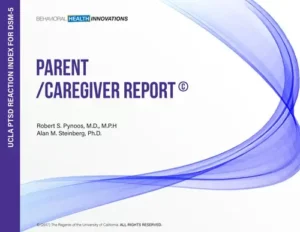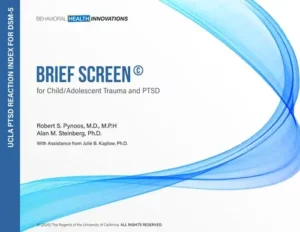



Welcome to the UCLA PTSD Reaction Index Automated Platform!
This guide provides information on how to create patient records, access and administer the automated versions of the UCLA PTSD Reaction Index, and derive test results for each administration. Versions of the Reaction Index available for electronic administration include:
- The UCLA Brief Screen for Child/Adolescent Trauma and PTSD
- The UCLA PTSD Reaction Index (Child/Adolescent version)
- The UCLA PTSD Reaction Index (Parent/Caregiver version)
- The UCLA PTSD Reaction Index (Parent/Caregiver version for Children 6 and Younger)
Getting Started
On the Landing Page of the Automated Platform, you will be able to Register Your Account and Sign In. You will also find under Resources links to download and print this User Guide, the Frequency Rating Scale (used by clients to assist them in making frequency ratings for the PTSD Symptoms section and the Distress and Impairment section), the Desk Reference for Administration and Scoring, and get access to FAQs. You will be able to create records for entering a new patient in your patient records and retrieving information for existing patients that you have previously entered.
Managing Patient Records
On the landing page you will find two selections, NEW ASSESSMENT and ASSESSMENT HISTORY. Clicking on the selection NEW ASSESSMENT will allow you to enter a new patient to be saved in your patient records. To add a new patient, enter the name of the patient in the space provided. You will then complete a Demographic section, including First Name, Last Name, Date of Birth, Gender, Ethnicity, Race, Grade in School, School, Teacher, and City/State. To enter Date of Birth, clink on the first arrow in front of the calendar to select the year, then use the calendar to select month and day. (You may also simply type in the date of birth in the space provided.) After entering that information and clicking NEXT, you will receive an acknowledgement that the new patient was successfully entered into your patient records. Clicking on ASSESSMENT HISTORY will give you access to all previously entered patients in your patient records. Type the name of the patient that you wish to select in the space provided and, when the list of patients appears, click on that patient’s name. That will bring up that patient’s assessment history with a list of each type of assessment that was previously conducted and the date of that assessment. You can then select the instrument that you would like to administer for that patient.
Administering Assessments
You will be able to select and electronically administer the UCLA PTSD Reaction Index instruments for a new patient for whom you have just created a record or for an existing patient that has been previously entered and saved in your patient records. To administer a version of the Reaction Index, click on the selection NEW ASSESSMENT and type in the name of the patient to be assessed in the space provided and then click on that patient’s name in the list of entered patients that will be presented. Once you have selected a patient, click on the link to the measure that you want to administer. Each of the full measures (excluding the Brief Screen) includes a Trauma History section, a PTSD Symptoms section, a Distress and Impairment section, and a section for entering Clinical Impressions/Progress Notes. For the first administration, administer the measure in full. For subsequent administrations, you will typically administer only the sections on PTSD Symptoms and Distress and Impairment, and you will find an option that allows you to skip the Trauma History section. If a new trauma is revealed or occurs, you can go back to the Trauma History section to enter new information.
Assessment Results
After each assessment, the Automated Platform will generate printable Test Results. Results include at the top, the Demographic information that you entered when first created a record for that patient, a depiction of Trauma History including each trauma type endorsed, trauma specific details, type of exposure (victim, witnessed, learned about) and age(s) over which the trauma occurred. Results displayed will also include Total PTSD Symptom Score (with a cutoff score where applicable), frequency scores for each PTSD symptom within symptom categories (Intrusion, Avoidance, Negative Cognition/Mood, and Arousal/Reactivity), and scores obtained within the Distress and Impairment section. Test Results will also include indication of whether diagnostic criteria for PTSD and Dissociative Subtype are met. Clinical notes entered in the Clinical Impressions/Progress notes will also be displayed. [Note that for the Parent/Caregiver version and the Parent/Caregiver version for Children Age 6 and Younger, there is a possible response option “Don’t Know.” Test results will indicate this response to the PTSD symptom items and the distress and impairment items, as the increasing number of “Don’t Know” responses compromise the validity of these scales.]
For repeated administrations of the PTSD Symptom section, the Distress and Impairment section, and the Clinical Impressions/Progress Notes, you may skip the Trauma History section and complete just these sections. After readministering these sections, the Automated Platform will generate test results showing successive scores for Total PTSD Score, a table of frequency scores for each PTSD symptom within symptom categories, and scores obtained within the Distress and Impairment section to permit examination of change in these scores over the course of treatment and for documenting clinically significant treatment outcome. Clinical notes entered in the Clinical Impressions/Progress Notes section will also be included in the presentation of Test Results for successive administrations.
